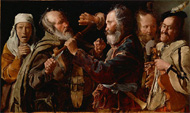1. Begin the lesson with a 30-second look using a reproduction of The Musicians' Brawl by Georges de la Tour. (Instructions for this exercise are available in this lesson: Thirty-Second Look.
After students have discussed their first impressions and you have gone back to the image for a second look, tell them that they will be discussing the narrative aspects of the painting. Use the following cues and questions:
• Which figures in the painting hold props? What do the props reveal about the story?
• Which figures are gesturing and what do their gestures reveal about the action of the story?
• Who are the main characters in this painting? What makes you say that?
• Look carefully at the composition and space in the painting. Where has the artist used these elements to focus our attention on certain parts of this painting?
• What aspects of the story has the artist highlighted using these visual elements?
• The two men in the center are fighting. What is the reaction of the onlookers? What do their facial expressions convey? What might they be fighting about? What evidence in the painting supports your idea?
2. Tell students that aside from the clue given in its title, The Musicians' Brawl, no one is certain what this painting depicts. Though this painting does not tell a known story, a drama is certainly depicted. Art historians have suggested possible stories:
• The two musicians are fighting over a good corner on which to play music.
• The painting depicts a scene from an unidentified contemporary play.
• The painting is meant to illustrate a common proverb from the time: "Wretched is he who can find no one more wretched than himself." This proverb makes the observation that a person who thinks he or she is in a bad situation can always find someone worse off. Street beggars and musicians like those depicted in this painting were examples of how low a person could fall in the social order.
3. Divide students into small groups and have each group spend 10 minutes developing an argument for one of the three possible scenarios, using visual evidence to support their view. Have the groups present their arguments to the class.
4. Give students the following assignment for homework:
Imagine that you are a reporter who has just arrived on the scene of this painting. You have to file a story of 1000 words describing the incident. Include the following:
• An opening sentence that answers the "Who, What, When, Where and Why" for this story.
• A description of the incident including some background on the main characters.
• Eyewitness accounts from each person at the scene.
|
 |
 |
 |
| The Musicians' Brawl, Georges de la Tour, about 1625 |
 |
|
 |
Common Core Standards for English Language Arts
Grades 6–8
WRITING
Text Types and Purposes
3. Write narratives to develop real or imagined experiences or events using effective technique, well-chosen details, and well-structured event sequences.
Production and Distribution of Writing
4. Produce clear and coherent writing in which the development, organization, and style are appropriate to task, purpose, and audience.
SPEAKING AND LISTENING
Comprehension and Collaboration
1. Prepare for and participate effectively in a range of conversations and collaborations with diverse partners, building on others' ideas and expressing their own clearly and persuasively.
2. Integrate and evaluate information presented in diverse media and formats, including visually, quantitatively, and orally.
Presentation of Knowledge and Ideas
4. Present information, findings, and supporting evidence such that listeners can follow the line of reasoning and the organization, development, and style are appropriate to task, purpose, and audience.
Visual Arts Standards for California Public Schools
Grade 6
1.1 Identify and describe all the elements of art found in selected works of art (e.g., color, shape/form, line, texture, space, value).
1.2 Discuss works of art as to theme, genre, style, idea, and differences in media.
4.1 Construct and describe plausible interpretations of what they perceive in works of art.
Grade 7
2.5 Interpret reality and fantasy in original two-dimensional and three-dimensional works of art.
4.2 Analyze the form (how a work of art looks) and content (what a work of art communicates) of works of art.
Grade 8
4.3 Construct an interpretation of a work of art based on the form and content of the work.
English—Language Arts Standards for California Public Schools
Grade 6
Writing:
1.1 Choose the form of writing (e.g., personal letter, letter to the editor, review, poem, report, narrative) that best suits the intended purpose.
1.2 Create multiple-paragraph expository compositions:
a. Engage the interest of the reader and state a clear purpose.
b. Develop the topic with supporting details and precise verbs, nouns, and adjectives to
paint a visual image in the mind of the reader.
c. Conclude with a detailed summary linked to the purpose of the composition.
1.3 Use a variety of effective and coherent organizational patterns, including comparison and contrast; organization by categories; and arrangement by spatial order, order of importance, or climactic order.
2.2 Write expository compositions (e.g., description, explanation, comparison and contrast, problem and solution):
a. State the thesis or purpose.
b. Explain the situation.
c. Follow an organizational pattern appropriate to the type of composition.
d. Offer persuasive evidence to validate arguments and conclusions as needed.
Grade 7
1.1 Create an organizational structure that balances all aspects of the composition and uses effective transitions between sentences to unify important ideas.
1.2 Support all statements and claims with anecdotes, descriptions, facts and statistics, and specific examples.
Grade 8
1.1 Create compositions that establish a controlling impression, have a coherent thesis, and end with a clear and well-supported conclusion.
1.2 Establish coherence within and among paragraphs through effective transitions, parallel structures, and similar writing techniques.
1.3 Support theses or conclusions with analogies, paraphrases, quotations, opinions from authorities, comparisons, and similar devices. |
 |

|
 |



